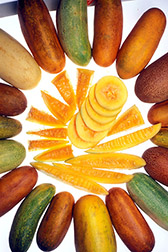New Cukes Boast Higher Beta Carotene
|
|
There could be an orange pickle in your future. Consumers in the United States and in developing countries would gain nutritionally from a pickle that packs beta carotene—the human body's source of vitamin A.
Plant geneticist Philipp W. Simon at ARS' Vegetable Crops Research Laboratory in Madison, Wisconsin, and former University of Wisconsin graduate student John P. Navazio have developed three breeding populations of high-carotene cucumbers. These are the starting materials for vegetable breeding companies to use in developing orange cucumbers.
But the orange color still varies to some extent from plant to plant and from one field or location to another. Says Simon, "We don’t always know that these crosses are producing fruit of a different color." He says he still has to slice into the cucumber to see whether or not it has an orange flesh.
But it is certain that Simon has added carotene to a food that otherwise would contain only minuscule amounts of this nutrient. Fruits from Early Orange Mass (EOM) 400 and EOM 402 contain from 1 to 25 ppm (parts per million) total carotene, with an average of 5 ppm.
Now, ARS and the Wisconsin Agricultural Experiment Station in Madison are releasing the germplasm of EOM 400, EOM 402, and Late Orange Mass 404. Simon and Navazio, who is now a vegetable breeder with Garden City Seeds in Victor, Montana, developed these populations by crossing U.S. pickling cucumbers with the Xishuangbannan cucumber from the Orient.
Simon is no stranger to genetically altering the color of foods or their nutrient value. In work that started 30 years ago, the late Clinton E. Peterson, an ARS plant breeder, began breeding for darker orange color in carrots. When Simon joined Peterson in 1977, he expanded the effort to laboratory measurement of carotenoid levels, to accelerate the breeding process.
Their work led to a change in the color of carrots from yellow orange to a dark orange and a boost in the carotene level from 70 to 140 ppm. [See "Science in Your Salad," Agricultural Research, Oct. 1994, pp. 28.]
Beta carotene, one of more than 600 naturally occurring carotenoids, is found in most fruits and vegetables and converted by the body into vitamin A. Carotenoids, including beta carotene, may reduce the risk of certain cancers and heart disease because of their antioxidant activity.
The Recommended Dietary Allowance for vitamin A for females aged 11 to 51-plus is 800 RE's (retinol equivalents, a unit of vitamin A activity). For males of the same age, the RDA is 1,000 RE's. Meeting these requirements requires 4,800 micrograms and 6,000 micrograms of beta carotene, respectively.
A modest 1-ounce serving of the improved cucumber (with 5 to 25 ppm beta carotene) would contribute 143 to 715 micrograms of the nutrient. This would meet 3 to 15 percent of the RDA for females and 2 to 12 percent of the males'. A 10-percent contribution to the RDA is considered quite good for a food item consumed largely as a relish, condiment, or salad component.
Although at least 5 years away from commercial development, varieties from these new breeding stocks could yield cucumbers and pickles with as much carotene as melons. Home gardeners, as usual, could get the jump on other consumers, since novel vegetable varieties are often first tested in that market.
And while the flavor of an orange pickle would be no different from any other pickled cucumber, its nutritional content would be better, says Simon.
"We were surprised to find that pickles made from these experimental populations retained their nutritional quality. Normally, vitamin C and some B vitamins are lost during food processing."
Until the improved cukes become available, other good sources of vitamin A include yellow and orange squash, sweet potatoes, tomatoes, and cantaloupe and other melons.
Simon began this research project about 8 years ago. Partial funding was provided by the Pickle Seed Research Foundation in St. Charles, Illinois.
— By Linda Cooke, ARS.
Philipp W. Simon is at the USDA-ARS Vegetable Crops Research Unit, University of Wisconsin-Madison, 1575 Linden Drive, Madison WI 53706; phone (608) 262-1248, fax (608) 262-4743.
"New Cukes Boast Higher Beta Carotene" was published in the November 1995 issue of Agricultural Research magazine.







